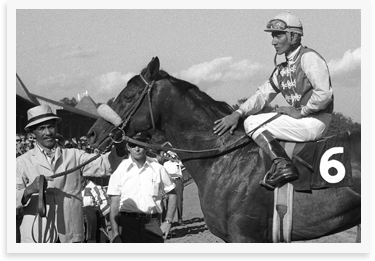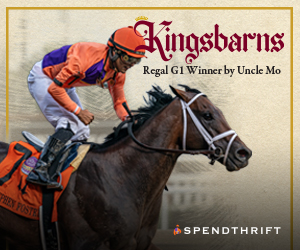
By Nick Costa
Growing up in Western New York, I use to listen to announcer Van Miller call the Buffalo Bills football games on local radio, and when the second quarter had come to an end, no matter how close the score or how big a deficit, Miller faithfully always reminded his listeners: “Well folks, that’s only the half of it.”
Miller’s signature phrase perfectly describes the 1972 thoroughbred racing season.
Had the Greater Buffalo Hall-of-Fame announcer been behind the microphone in 1972 calling horse races instead of football games, I’m convinced Miller would have implemented his tag line following Riva Ridge’s win in the Belmont Stakes in June, because despite the juvenile Champ from 1971 winning two-thirds of the 1972 Triple Crown and comfortably sitting atop the division for three-year-old honors – well folks, that was only the half of it.
After a three-week break following his Belmont score, trainer Lucien Lauren shipped Riva Ridge to the west coast to contest the 10-furlong Hollywood Derby and the Meadow Stable runner escaped with a neck victory after setting a fast pace throughout.
That would be the last win of the year for Riva Ridge, who proceeded to lose five straight, including two in which he finished behind Key to the Mint, a colt who was withheld from the Kentucky Derby by trainer Elliot Burch because he felt his horse wasn’t fit enough for the big race, but was ready in time for the Preakness where he finished third, a neck in front of Riva Ridge. In the coming months, the racing world was about to find out that Key to the Mint had made tremendous physical strides from at age three.
During the time Riva Ridge began heading south in the performance department, Key to the Mint, owned by Paul Mellon’s Rokeby Stable, started his ascension with a four-race winning streak. His first conquest after finishing fourth behind Riva Ridge in the Belmont was a victory over older horses in the one mile and three-sixteenths Brooklyn Handicap where Key to the Mint equaled the track record. Next up was the Whitney Stakes on the first Saturday in August at Saratoga where once again Key to the Mint was pitted against and defeated his elders. On that same day, Riva Ridge was a dubious fourth in the Monmouth Invitational, an effort that was later attributed to the effects from a tranquilizer the horse was mysteriously given.
Lauren immediately gave his Kentucky Derby and Belmont winner six weeks of rest and while the ‘big cat was away, the little mouse played” With Riva Ridge on sabbatical, Key to the Mint returned to his own age group and won the Travers Stakes in front of a then record crowd.
The gap between the two horses was beginning to narrow quickly.
Elliot Burch’s next target for Key to the Mint would be the Woodward Stakes at the end of September. For Lucien Lauren, he knew for his horse to stay in the mix for year-end honors in the three-year-old division, Riva Ridge would not only have to face Key to the Mint in the Woodward but would need to defeat the Rokeby Stable star.
But first, Riva Ridge needed a tune-up race and Lauren had selected the Stymie Handicap at Belmont, but Riva Ridge fell victim to Canonero II, losing the mile and one-eighth contest by five lengths to the 1971 Derby and Preakness winner in world record time.
Despite his losing skid, the crowd at Belmont Park made Riva Ridge the 7-5 favorite for the mile and one-quarter Woodward Stakes. The track came up sloppy, but Laurin didn’t seem to be concerned about a surface that certainly attributed to his horse’s fourth-place finish in the Preakness Stakes which ended the Triple Crown dream and the fourth-place finish in the Everglade Stakes at Hialeah in April.
On the morning of the Woodward, Laurin told Sports Illustrated “This surface won’t bother Riva at all. The going here won’t be at all like the slippery, greasy muck in the Preakness at Pimlico. None of us should have an excuse.”
The Rokeby Stable star certainly had no excuse. After dueling most of the way with the Kentucky Derby/Belmont winner in the slop, Key to the Mint pulled away in the stretch to win, as Riva Ridge faded to fourth.
Following the Woodward, Key to the Mint’s jockey Braulio Baeza told the Associated Press, “They said you could never look Riva Ridge in the eye and pass him. Well, we looked him in the eye and you know who passed who.”
For Riva Ridge, it was now the third time in his three-year-old season he finished fourth on a track labeled sloppy. The gooey surface appeared to be his kryptonite.
With the victory, Key to The Mint, took another major step toward the 3-year-old championship, and whispers began about possible horse of the year honors.
Four weeks later at Aqueduct, the two rivals would face one another in the two-mile Jockey Club Gold Cup, this time over a fast track. Another win by Key to the Mint would surely solidify three-year-old honors, but also would help strengthen his push for Horse of the Year recognition. Riva Ridge needed to win to ‘upright a sinking ship’, but in a surprising upset, Autobiography, who had been defeated by Key to the Mint in three previous meetings, delivered a definitive performance, winning by 15 lengths over the Travers winner who finished three lengths ahead of Riva Ridge. The victory was impressive enough that it garnered Autobiography an Eclipse Award for older male. The four-year-old raced in the colors of owner Sigmund Sommer and was trained by Frank Martin. The owner/trainer combo were campaigning a two-year-old colt out west named, Sham, while at the same time, Laurin and Meadow Stable were boasting about their ’other’ horse, Secretariat.
Following the JCGC, Key to the Mint’s 1972 campaign was over, but the bay colt’s summer performances were enough to sway the majority of the sports turf writers to cast their votes for him as Champion three-year-old.
Riva Ridge had one more start in the Washington, D.C. International where on soft footing he lost by 38 lengths. There would be no award for him.
If writer Charles Dickens could have penned the 1972 racing season, he may have implemented a variation on a theme, that is, he would have borrowed from his ‘Christmas Carol’ novel, conjured up a ‘Ghost of Racing Future’ and titled the book: “A Tale of Two Horses.”
And well folks, that was the other half of it.
Photo: Key to the Mint (Courtesy of NYRA)



